Future Tech Innovators

With tremendous increase in cutting-edge technologies such as Artificial Intelligence, Quantum Computing, 5G mobile broadband, 3D printing, etc., India has begun to carve a path towards establishing an ecosystem that fosters innovation. Technology-led startups and young innovators are adapting and adopting new technologies and innovations to tackle complex issues and keep pace with the times. They are fostering innovative ideas to meet the challenges ahead and their future tech innovations are driving the nation. The recent India Mobile Congress (IMC) 2023, in Delhi, was a perfect platform to showcase these future tech innovators and their innovations. Corporate Citizen in engaging conversations with some of these pioneering innovators, bring you a taste of these future innovations brewing in India
Smart AI Luggage

Our recently launched AI Buddy Luggage, is a pioneer Smart Luggage brand in India. This innovative luggage incorporates cutting-edge technology, featuring built-in sensors and advanced AI capabilities. Its integrated tracking systems allows you to keep tab on whereabouts of your luggage. The luggage boasts a smart fingerprint lock system for enhanced security and integrated charging to keep your device powered throughout your journey.
What sets AI Buddy Luggage apart is its multifunctional design, not only can it follow you wherever you go but also doubles as a Smart motorised rideable luggage. Its robust construction is capable of bearing up to 120 kilograms and move at speeds of 5-7 kms/hour speed. It is equipped with a detachable and rechargeable battery.
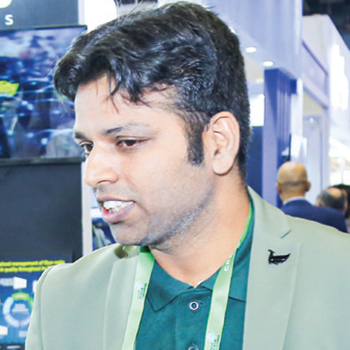 Atul Gupta, Cofounder, Arista Vault
Atul Gupta, Cofounder, Arista Vault
You can operate the AI Buddy luggage device through a user-friendly app on your mobile phone or through a remote control. The AI algorithm sensors combined with GPS Tracker, make the luggage anti-lost and anti-theft, while also enabling obstacle detection and dodging.
Arista Vault is a technology start-up and our mission is to make human life simple, easy and safe. Our Smart Luggage is designed to address common travel pain points, making your trips more enjoyable and stress-free. The company has garnered support and funding from Government of India, Ministry of Electronics and Information Technology, under Electronics System Design and Manufacturing (ESDM), in collaboration with Software Technology Parks of India (STPI) and Electropreneur Park in 2019.
We started our journey in 2017 launching Wallet-Bot smart wallet, which has anti-theft and anti-lost features. Currently offering a 33-litre capacity model, Arista Vault has exciting future plans, with additional designs in the pipeline, including a 52-litre capacity model.
Zero energy 6G Sweater
This Zero Energy 6G Sweater displayed here, comes with pressure sensitive sensors integrated all over it. What’s so peculiar about these sensors is it does not rely on battery power in order to work. It can be made to source the required energy from the surrounding—such as harvest energy from vibrations, from light, from temperature gradients, or even from the radio-frequency waves.
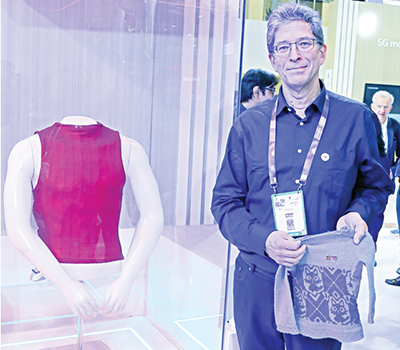 Stefan Parkvall with Zero energy 6G Sweater
Stefan Parkvall with Zero energy 6G Sweater
Ericsson Research in a joint research collaboration with Massachusetts Institute of Technology (MIT) has developed this Smart Textile that can sense and react to environmental conditions or stimuli.
For example, the red sweater displayed here, is weaved with special electric wires and where these wires criss-cross, those points are imbedded with pressure sensors. There are hundreds of these pressure sensors imbedded all over the sweater. The collective sensor readings go to a AI model, which is based on the sensor reading of the pressure distribution over the person’s body, can predict what the person is doing, if the person is sitting, lying on the couch, leaning against the wall and so on.
The varying applications of these newly developed pressure sensors can be utilised in the farming industry to monitor crop yields, or for traffic monitoring signals and so on.
The Smart Textile can be used in medical applications—for example it can alert the wearer with back pain, not to be in certain positions, as recommended by their doctor. It can have sports applications—for example, during a practice session, it can be used to detect if you are moving in the right way. There are limitless potentials for these Smart Textiles.
Talking about the connectivity part of it, to make this device wireless, we at Ericsson Research jointly with MIT, developed a chip which will eventually go on this sweater. The sensors imbedded on the sweater is connected to the chip. The chip will transmit the sensor information to the network for AI interpretation.
For this recent battery-less Smart Sweater, project, we decided to go for something difficult and push the technology. We decided to try harvesting energy from the radio waves that surrounds us—we are talking about fractions of microwaves, power that exists at very low levels. We can actually harvest this energy with this chip—combining the 6G technology standards with AI-interpreted information will influence the design of the network to optimise energy efficiency and connectivity.
This technology is still in the experimental stage and being researched. We are looking forward to have a standard use case till the year 2030.
Digitally Smart Building
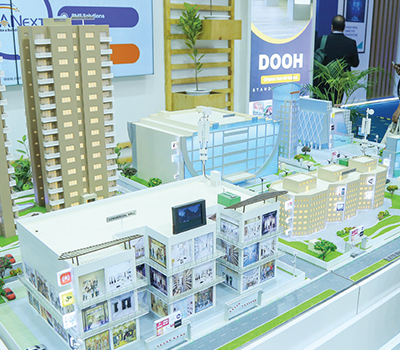 Prototype of how a Smart Building looks and works
Prototype of how a Smart Building looks and works
These are prototypes of how Smart Buildings will look and function. The presentation here has prototypes of a residential complex, office complex, marquee, IT tech park, Government project and a commercial mall.
RANext (A Space World Enterprise) is into Neutral Network Infrastructure (NNI) and has exclusive tie-up with the developers for a period of 20-25 years. What we will do is take all the requirements from the developer as well as the customer side and then build the FTTx as per their requirements. While FTTH is Fiber to the Home, in the FTTx the ‘X’ stands for anything, which includes internet, surveillance CCTVs, FTTH, boom barriers, alarms, Wi-Fi zones, user defined dashboards and many other applications and devices—all these will be created by RANext for the Smart Building.
RANext offers end to end solutions for all the integrations starting from technical consultation, design and installation, extending to the operation and maintenance of the Smart Building project. We also carry out business management systems, which is asked from the developer’s side—the end user could be a B2B or B2C.
We have exclusive tie-up with all the internet operators. For example, if you take one residential building with say around 500 flats, each will have internet connection serviced by different operators. Thus the building will have number of service provider cables, antennas, Set Top boxes. What we will do is, convert all these connections into a single cable —provide all the operators and the service providers with a single cable.
Smart Vehicle Technology
Dimensity Auto cockpit solution
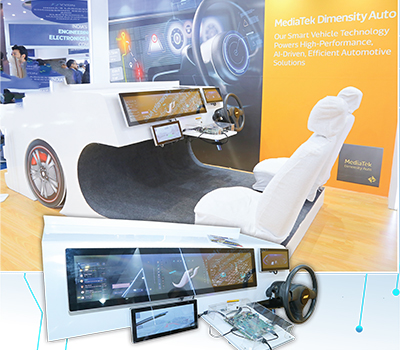
The MediaTek Dimensity Auto, is a complete auto cockpit solution, which makes for an awesome driving experience. Our Smart Vehicle Technology powers high-performance and AI-driven, efficient automotive solutions, for cars of the future.
The auto cockpit solution showcased here has two screens. One is the cluster screen, which is used for driving the vehicle. The second screen is the infotainment screen, which is divided into three parts.
One part of the infotainment screen allows you to operate functions like connectivity, GPS, air-conditioning, etc., in the car. The second part of the infotainment screen includes access to your multimedia needs for listening to music, chatting, taking calls, watch videos. Instant messaging and so on. The third screen is for the 360-degree surveillance and security cameras, which gives you the outside views of your vehicle for reversing, parking and so on. More screens can be added to this console to make your car more intelligent.
The Smart Vehicle Technology makes your experience really holistic and interesting while driving. While you are driving a car you need the cluster screen, which has the speedometer and lots of other graphical information, including the map for navigation, climate control system, an interactive screen for chatting, watch videos and so on.
The chipset displayed in front of this screen supports the premium quality solution to enable many advanced driver-assistance systems (ADAS) applications for higher-end cars. For low cost cars, we have a downgraded chipset solution also. However, the PCB remains the same.
MediaTek is a Taiwanese chipset company, and this Smart Vehicle Technology solution is available for many of the OEMs globally, utilising MediaTek solutions.
People-Tech 2-wheeler Smart Digital Cluster
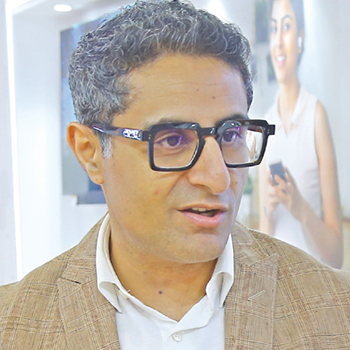 Anuj Sidharth, Deputy Director,
Anuj Sidharth, Deputy Director, Marketing and Communications, MediaTek India
MediaTek is working on a connected electric vehicle cluster called the People-Tech 2-wheeler Smart Digital Cluster. The average vehicles on the road don’t have any Smart connectivity. As part of the connected electric vehicle cluster, you can stay connected with your vehicle. From your mobile phone you can monitor the health of your vehicle, schedule your vehicle servicing, if there is theft of your vehicle you can remotely track your vehicle. There is also an on-board navigation system provided with the vehicle, to operate while you are driving. You can take the notifications, take calls, search for nearest charging station, all these facilities can be accessed on the go. You can get alerts about the health of your electric vehicle battery, such as the remaining driving range in kilometres, schedule an appointment with the charging station, which is on the way. The infotainment solutions like access to video, social media and other multimedia can be accessed only when the vehicle is in stationary mode, for safety purpose.
Reliable drones for today and tommorow
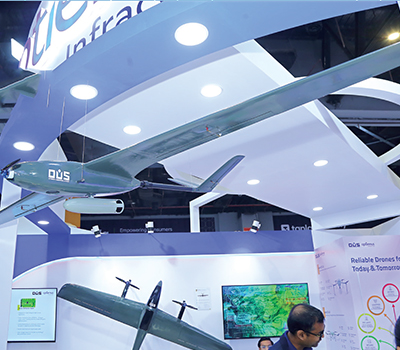
Optiemus Infracom Limited is a listed company and our pavilion at Indian Mobile Congress (IMC) 2023, showcases our foray into unmanned drones. We have been working on this drone project for the past one year and are proud to launch seven drones during this event.
Our main focus is indigenisation. Over a period of time we are planning to make the drones completely ‘Made in India’ and the idea is to control all the aspects of the designing and manufacturing in-house. Our aim is to have control over the complete ecosystem, so we can make more high performing and reliable unmanned drones. To meet the reliability standards that will bring us success, our research and manufacturing ecosystem must be controlled and seclusive.
We have launched seven drones and three of them are the Quadcopters. The beauty of these drones is the functionality, which is very standardised and can be used in multiple-use cases across industries. They can fit in the defence industry, they can fit in agriculture sector, they can fit in railways, roadways, construction sectors and so on. That is because the products have been made hot-swappable—if you want to mount cameras for surveillance, mapping, rescue missions, you can do that. The kits installed on these drones are removable and can be fitted with other kits with different purposes. A relevant kit can spray fertilisers in the field, while other can be used for a medical aid drop—the drones are capable of multi-functionality.
The main purpose to showcase our drones at the IMC is to get the word out, engage with potential clients and understand their requirements. This is a very initial stage wherein we wanted to announce that we are in the market and it becomes believable.
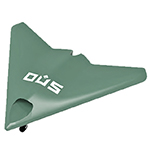
Abhedya Drone
This is our engine powered drone which comes with a jet engine and is one of the top of the line drone. This can carry a payload of up to 30 kgs. These are long distance machines to carry heavy payloads.
Catapult launch drone (Darsh, Ajeya VT 8.0 and Marak PL 7.0)
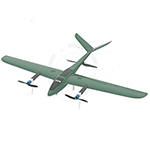
This is our catapult launch drone, for more
long range missions. This can have a flying
time of more than 2 to 3 hours. In cases you
need to have higher flying time to go further
out, these type of drones are more effective.
One of it has a benefit called VTOL (Vertical
Take-off and landing)—usually in places
where there is no runway, it takes off as a
helicopter, then it takes a fix wing formation, wherein rotors move on the axis and
they catch the normal speed for a longer range fly.
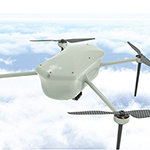
Vajra (The Quadcopter Drone Series)
We have named them Vajra QC 2.0, 6.5 and 10.0—these three drones come in different sizes and capabilities. As they get bigger the amount of time they can stay in the air changes and the amount of payload they can carry changes. Clients come with different requirements and they can find a perfect fit out of the three Vajra models, for their purpose.
(These drones are not for civilian use, they are for B2B applications across industries.)
Direct To Mobile (D2M) Broadcast Solution
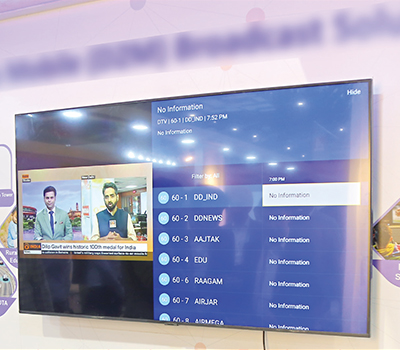
What we bring to the table for Tejas and for the Tata ecosystem, is the ability to design and develop chipsets and silicon processors. These are our first and second generation chipsets, which are essentially software defined RAN chipsets—they are system on a chip. As it is software defined, we can use the same SDR chip for lot of different applications, whether they are SATCOM applications, broadcast applications. The application that we are presenting here to the public is Direct To Mobile (D2M) broadcast application.
With the D2M application you can broadcast content over a cellularised broadcast architecture, directly into the mobile. The mobile can be in an airplane mode, it can have its Wi-Fi turned off or have no Wi-Fi availability, or may be not even have a SIM and still you can watch broadcasted content—content that could be fed into the broadcast core, by content operators, by content generators, by Netflix, Hotstar, Prasar Bharati or JioCinema. All such content can be fed into the broadcast core and can be received in an airplane mode without any SIM card or Wi-Fi connectivity, directly into the mobile.
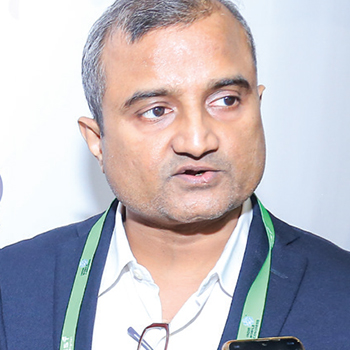 Prashant Maru, VP-Sales
and Business Development,
Prashant Maru, VP-Sales
and Business Development,Saankhya Labs (acquired by Tejas Networks)
Some of the other applications for the D2M network are remote education broadcast, Software over-the-air (SOTA) software upgrades for broadcast, content offload, MNO offloads. Content causing extreme congestion in a mobile network which is consumed at the same time by millions of subscribers, can be selectively offloaded from the mobile broadband network into a D2M broadcast network.
For example, a broadcast content, whether it is audio-video content, radio or audio only content, educational content—you can broadcast different kinds of content over a D2M broadcast network. Intent of doing this is to create a data pipe, which is like a secondary down link to the mobile operators, an alternative network for content owners to transmit and send their content and their data.
At present we are carrying out D2M trials in Delhi city and we hope to scale up the trial to cover a large part of Delhi NCR. This trial is being done in collaboration with Prasar Bharati and IIT-Kanpur as our technology partner. When I say scale up, what we are trying to do is a pre-commercial trial, eventually it will be launched as a commercial service. Once the results of the pre-commercial trials are available, we will look forward for its launch, which may take around 6-12 months.
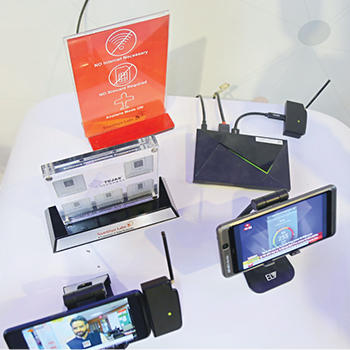
The cost is normally a functional volume, but some of the business case that we are looking at—we have kept lot of permutations and combinations of the business case. One that we really like, which we feel will be beneficial to the mobile operator, to the broadcaster and to the end user, is the business case that we are going to finalise, work and finesse it. But, the goal is to create a service which is on the same line as the service that is already launched by Prasar Bharati, which is called the Free Dish service. So, on the same lines we want to create a free stream service, meaning free dish directly into the mobile. You will not need to pay any subscription, that is what I mean.
What is displayed here is the chip, which is embedded into the mobile, this is a typical of-the-shelf LTE phone, plus Delta, which is the chip embedded into the phone and the UHF antenna. In this case the chip is in the dongle, all you need to do is plug the dongle into the USB type-c port in an Android phone, download the application and you can start receiving the broadcasted content.
The third option is, you connect the dongle to a set-top box and feed the set-top box output into the TV, to receive the content on the TV. We are working with mobile manufacturers to get our chip embedded in their phones, so that it becomes easier. Right now this is just an engineering version of the phone, just a prototype.
Automating irrigation process
 (L-R) Prakhar Mani Tripathi and Nishi Patil, cofounders
(L-R) Prakhar Mani Tripathi and Nishi Patil, cofounders
We are a startup based out of Jabalpur and through ‘Krishi Verse’ app we are sowing the seeds of change in the agriculture sector. Through this innovative startup, we aim to solve one of the biggest problems the farmers in India face during the irrigation process. Our startup helps farmers automate their irrigation process by providing a set of hardware and software-based devices. These devices can be easily managed through our Krishi Verse app. We have developed three devices that can be controlled using our mobile application.
The first device Dhara—collects data about the soil and the amount of water required for irrigation based on the crop type and stage. This data is sent to the user, who can then make informed decisions about the amount of water needed for irrigation. The second device is Neer, which can easily control and manage the irrigation process through any type of pump, including single-phase, three-phase, monoblock and submersible pumps. Users can turn on and turn off the pumps at any time and from anywhere in the world. The third device is the Pravah, which helps manage the flow and direction of water during the irrigation process. Users can transfer water from one field to another without any human intervention. All these devices can be operated using Krishi Verse app.
 Anupama Upadhyay, Business Development Manager
Anupama Upadhyay, Business Development Manager of Krishi Verse, at IMC 2023
Me and my team come from agricultural background. During the Covid-19 pandemic and even afterwards, everything became very difficult for the farmers. They struggled to adapt to the changing environment. I often saw my uncle’s struggle, who would take a long walk to the farms, many times during the night hours, just to switch on the water pump. I had just completed my engineering education and seeing my uncle face this challenge made me think as to how I can automate the water pump operation. Using my engineering education, I developed this app, ‘Krishi Verse’.
Currently, around 300 clients are using our product and we have received positive feedback from them. At the moment, we have only launched the Neer device in the market, while the Dhara and Pravah devices are still under development. Both of these devices are being made as per the requirements of the farmers. Neer is available through online shopping sites like Amazon and Flipkart, and most of our customers are from South Maharashtra, Gujarat and Uttar Pradesh.
We started our company in December 2021 and launched Neer, six months back. We started our startup at STPI (Software Technology Parks of India) and received funding of Rs 25 lakhs from them. In addition to this, we have received some grants under different government schemes.
New mode of medical assessment

The PhysioAI, is a revolutionary app for assessing muscles and bones and stands out as a pioneer of innovation in the world of healthcare technology. It is a musculoskeletal assessment application, which is a SaaS based product, primarily designed for the rehabilitation industry, sports academies for assessing athletes for their performance, physiotherapists, orthopaedics and neurologists, for assessing people who are having difficulties with any kind of musculoskeletal motion. It is designed to revolutionise the way we evaluate and address musculoskeletal concerns.
The PhysioAI application is a deep learning product—it uses a deep learning process for assessing the motion analytics of patients. In addition to the different assessment tests, it provides the recommended therapy plans, which the patients can easily follow through videos uploaded on to the app. This app also suggests the patients about right and wrong techniques in real time, while they are doing therapies, watching the videos. It also helps with fast recovery and increases their adherence, saving time for the patient.
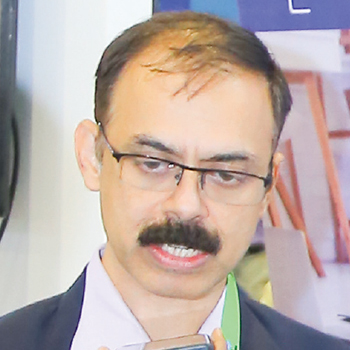 Rahul Bajaj, Founder, PhysioAI (Darwin Digitech)
Rahul Bajaj, Founder, PhysioAI (Darwin Digitech)
Just like a blood test report or a radiological test report, the patients can get a proper quantified report for anything that has happened to their muscle and skeletal structure, using this tool. There are around 800-1000 athletes who are currently being assessed using this particular application. In addition, close to 150 therapists are using it in different cities, including Delhi, Hyderabad, Bengaluru and Pune. We are also working on integrating these therapists into one platform so that a community can be created for ease of therapy delivery.
This particular application is being supported by the Department of Science and Technology. This application will be soon taken to tier-2 and tier-3 cities through a specially developed teletherapy module. Under this module, the district hospitals are going to be connected with the primary and secondary health care centres, which do not have the tele-therapy module.
Our company, Darwin Digitech, started in 2021 and is incubated at the Indian Institute of Technology (IIT)-Bombay. It is a NASSCOM (National Association of Software and Service Companies) and Deep Tech Club (DTC) recognised company. We have raised seed fund with Japanese angel investors, and are also funded by IIT Bombay and IIT Patna. In addition, the Centre for Innovation Incubation and Entrepreneurship (CIIE), which is the investment arm of IIM Ahmedabad, is also one of the investors in the company.
Transforming 3D Printing narrative
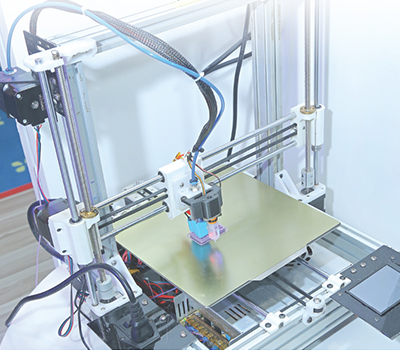
Focused on 3D printers and raw materials, we provide services like prototyping and reverse engineering. After spending four years in the 3D printing field, we noticed some key issues with existing 3D printers—they were slow and required technical know-how. Driven by a desire to make 3D printing accessible to everyone, we are ready to transform the industry's narrative.
Our 3D printer is right now ten times faster than normal 3D printers available in the market—it is intelligent, it can calibrate itself, it can know what issues are there and can solve those issues on its own. Further, in the coming months, we are going to integrate 5G into it, so that it can be controlled remotely from anywhere around the world. When we came up with this idea, we did immense research for two and a half years, and now we have almost completed the research and development stage.
Through my experience of selling 3D printers, what I have understood is that the drawback of these printers is, they are slow and they require a lot of technical knowledge to operate. It is difficult for a person without technical knowledge to operate these 3D printers. This was when we thought of making our own product, which solves these two issues — it should be very fast and easy to operate for anyone. That is what inspired me to start my own company that can manufacture this fast and easy to operate 3D printers. We started our company four years back and are actively looking for investors.
Smart Shoe Innovation
 Atman Acrobatic Shoe prototype attached with wearable
Atman Acrobatic Shoe prototype attached with wearable safety and tracker device
This Atman Acrobatic Shoe, is a customised for uses like, ensuring safety for women and children and military applications. This is a prototype and I eagerly look forward that my innovative shoes play a crucial role in ensuring the safety and well-being of people from all walks of life. It is an eco-friendly shoe, attached with piezoelectric plates (thin ceramic sheets that convert mechanical energy into electrical energy) and solar panels. The especially designed spherical ball shaped solar panel is attached to the top of the shoe.
I have also developed a safety device in the form of a chip that can be attached to the back portion of any footwear, the part least likely to get damaged. The product is designed to be concealed and customised for each individual user. When you click the SOS button, the GSM and GPS features are triggered, and the location of the user is sent via SMS to a designated person, along with the latitude and longitude coordinates for easy tracking.
This chip based device is particularly useful for army personnel. If they find themselves in danger situation, using this safety device they can be tracked and rescued. However, it is also designed to meet the needs of civil society. For example, if a child is lost or kidnapped, they can simply press the button to send an SOS signal and their current location. This is a two-way communication system that also allows parents to track their child's location using a unique code and password.
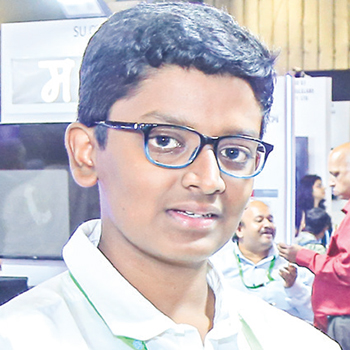 Akshy Kumarappan Annamalai, Creator,
Akshy Kumarappan Annamalai, Creator, Atman Acrobatic Shoes
What inspired me is a TV broadcast news, wherein they were reporting about a recently found dead body of an army personal, recorded as lost for last two years. Since they protect the nation, I thought, what can I do to help them get out of such situations. This idea led me to create a wearable safety and tracker device that anyone can wear. Immediately I joined a three months’ robotics class learnt the basics of robotics and used that knowledge to create the Atman Acrobatic Shoes. After a year of deep research, I created the first prototype.
I have not yet set a price for the product, but I plan to keep the cost as low as possible to serve society's needs. This tracker mechanism can be fitted into any footwear. It is important that people understand the need for this product to ensure their safety.
I am 13 years old studying in class 8th in Ahmedabad, Gujarat and currently managing both my studies and pursuing my passion. As a young innovator in this field, I have received lot of appreciation for my work and for my aim to serve society.
Redefining connectivity, securing communications
 Vikram Gupta, Founder and Board Member, Fibmesh
Vikram Gupta, Founder and Board Member, Fibmesh
In today's highly connected world, the growing risks of cyber threats are a significant concern and we are tackling this issue with our innovative project, ‘FIBMESH’. This project aims to enhance the security of every device and communication at the device level, to reduce the risk of unencrypted communications turning into cybersecurity problems. Currently undergoing testing, FIBMESH holds the potential to simplify networking, secure communications, and establish a global network accessible to individuals and businesses alike.
FIBMESH is basically neither software nor hardware. We are a network that spans across multiple data centres globally—close to around 33 data centres. The only difference between us and other networks is that with other networks you need to physically connect to them and you can connect with us through a virtual interface. We are network-agnostic, so you still need your existing service provider—we build a unifying layer on top of it to make everything seamless for you. When you create your network for your personal or official purpose, it is a network you create and manage. It is as simple as dragging and dropping a few elements and connecting them over the ground.
At FIBMESH, we ensure that all communication from your device is always secure and encrypted, and we also provide you with a consistent online identity in terms of a fixed IP address and a dual-stack IP address, so that your identity is yours for life. So till the time you're a subscriber, you can hop networks, you can change service providers, and your identity remains the same.
How FIBMESH works
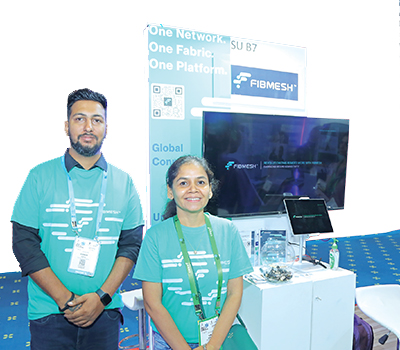 Revolutionising remote work with Fibmesh — the Fibmesh
Revolutionising remote work with Fibmesh — the Fibmesh pavilion with team members at IMC 2023
FIBMESH helps to keep all your communications secure. It will help you to have a consistent identity across networks so that if you want to enable network access control, you can whitelist your IP address. Whitelist is the only list that IPs can access for mobile applications. But you really can't do that because, for example, as you switch to your mobile app, your IP address changes because it's dynamic. But, after using this product, you have a dedicated IP and you can whitelist it. And, until the time you actually log into that particular application, using that interface, it will not allow you to log in or perform any activity. This is all implemented using a virtual interface, using cryptographic encryption that cannot be redone on another device. It can only be done on one device. So, if you want to actually shift it from one device to another, you have to come back to us. We'll reset your public and private keys, and then you configure it again, and it happens.
If somebody sees the change in the patterns of cryptography, it will kill the communications completely, ensuring that your data is always safe and secure. You don't need to be an expert in networking to do that. It's as simple as downloading an application, completing your KYC and just letting the application know, how you want it. Everything will happen automatically in the background. Right now, we're testing this product and it is not available for the public, but will soon be available for B2C uses.
Reimagining Critical Communications
Portable private 4G network solution
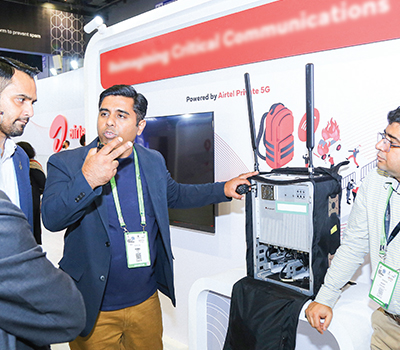 Demonstrating how the Athonet-Airtel portable private
Demonstrating how the Athonet-Airtel portable private 4G network solution for critical communication works
This critical communication device is developed by Athonet in partnership with Airtel. It is a portable private 4G network solution which can be used in situations like disaster management or riot control, when the existing telecom infrastructure might have been intentionally closed by the Government or it has been damaged due to some natural disaster. So, in such situations, the special forces which are working on the field, need to have a standard of communication and for that purpose this backpack created by Athonet, can be used. Basically it comprises of the radio, server and the antenna and there are specific SIMs which can be latched to it.
Just imagine a situation where there is no network and some army personnel or special forces have to work. In such situations someone can carry this backpack or it can even be loaded on a vehicle, as it weighs around16-17 kgs. This single device will create a portable 4G mobile network, for around 1.5 kms radius. But, using a different antenna it can also be extended to around 10 kms radius. All the devices which are having configured SIMs can be latched into this network and they can communicate to each other.
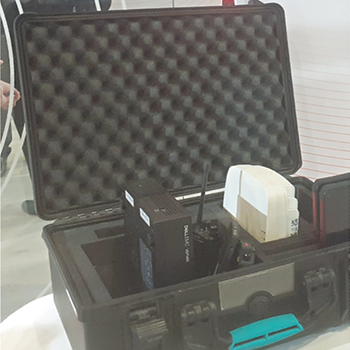 5G standalone starter kit
5G standalone starter kit
This portable private 4G network solution is different from a traditional walkie-talkie. With walkie-talkie you can only share voice, but with this device which will be connected to your phone, you can share and broadcast videos, voice call, messages, photos etc. It has a push-to-broadcast button. For example, as soon as the fireman is in a situation, he can start broadcasting the feedback of the situation to his team members. So, whoever is on the network and having that particular SIM on their phone will receive the broadcast. It is basically useful for tactical and security purposes only. Special security forces who need an access to phone, they can only access it, nobody else can interfere those signals.
5G standalone starter kit
The 5G standalone starter kit, has a 5G radio on it, on which multiple devices can be latched. It has the core device of 5G—if you want to do POC of 5G use case, usually it takes lot of man-hours and expensive equipment to set it up, but with this starter kit, you just need to plug in the 5G core and the radio and within minutes you will be able to see 5G SA signals on your devices.
Student Innovations from Delhi Technological University
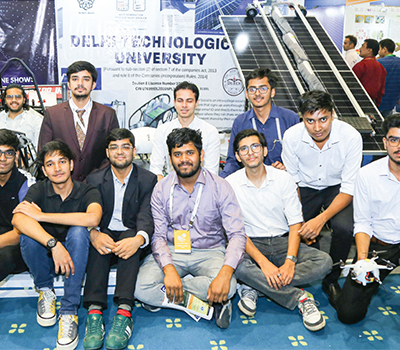 Student startup founders from Delhi Technological
Student startup founders from Delhi Technological University (DTU) pose at their pavilion
The student-led and tech-based startups from the Delhi Technological University (DTU) showcased their tech innovations at IMC 2023 tech fest.
Bubble Social (intra-college social media network)
A startup called “Bubble Social”, has created a private social media network for use in a college campus, wherein students can login through their college email ID. Bubble Social works as an intra-college social media network, which allows students to talk to their college mates.
Drones
A students team of DTU has developed cutting-edge drones of different sizes through their startup. One of the team members explained that the drones can be used to conduct light shows, similiar to what you see at the Red Fort, in Delhi, during the Independence Day celebrations. The students ingeniously used off-the-shelf items to build the drones, which can be used for drone light shows, performed by illuminated, synchronised, and choreographed groups of drones that arrange themselves into various aerial formations.
Autonomous Underwater Vehicle
The displayed prototypes of Autonomous Underwater Vehicle (AUV) and Remotely Operated Vehicle (ROV), are indigenously developed manned underwater submersible vehicles designed and developed by the DTU students. These cool innovations are underwater vehicles designed to reach the depths of 10 to 30 meters. The AUV can be used for surveillance and mine detection. The students said that they are working on a frequency radiation for the AUV, so that it can be also used to destroy landmines from a distance. The smaller ROV, is a surface vehicle, designed to reach a depth of 10 meters and capable for inspecting dams, ports etc.
Automatic Cleaning Robot for Solar Panel
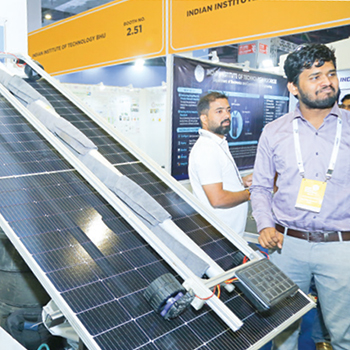 Automatic Cleaning Robot for Solar Panel
Automatic Cleaning Robot for Solar Panel
A demo solar panel with the prototype robot displayed, had a moving rod attached with microfibre, meant to catch dust. The solar panels are cleaned to a very high efficiency. A vacuum cleaner is also integrated with this device. The device works from the power generated by the solar panel, so it does not require any power from an outside source. This device also has sensors attached to it to detect damaged cells on the solar panel, so it can be replaced.
Formula Racing Prototype
These budding engineers of DTU also designed a formula racing car prototype. They said that designing and building a formula race car and then competing in a race is exciting. They have used their prototype in formula racing competitions nationwide.